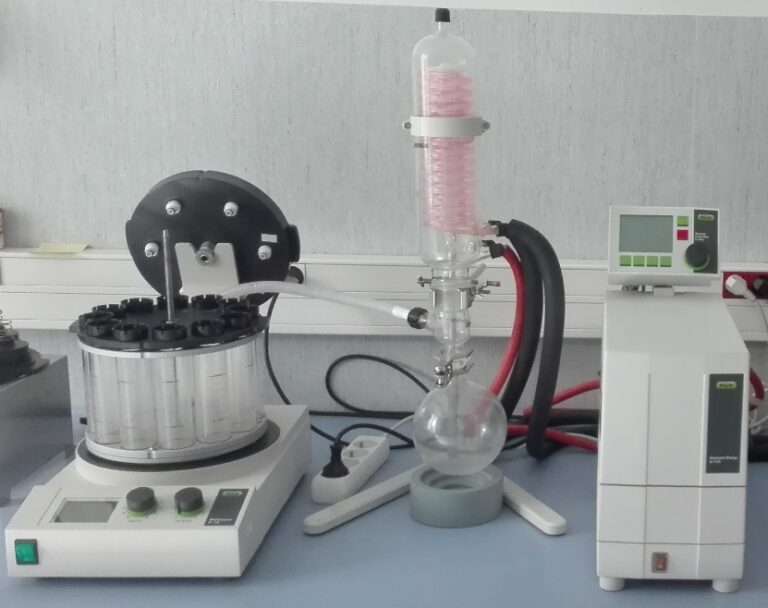Head of Department
dr hab. Iwona Kowalska
tel. (+48) 81 4786 883
e-mail: ikowalska@iung.pulawy.pl
Office: biochem@iung.pulawy.pl
tel. (+48) 81 4786 880
Department is located in the INCBR Center,
address: 8 Krancowa Street, 24-100 Pulawy
| Staff | Numbers |
|---|---|
| MSc Bibow Aleksandra | (+48) 81 4786 890 |
| MSc Bochra Tomasz | (+48) 81 4786 880 |
| Ciarkowska Barbara | (+48) 81 4786 887 |
| dr Jędrejek Dariusz | (+48) 81 4786 886 |
| dr Kowalczyk Mariusz | (+48) 81 4786 886 |
| dr hab. Kowalska Iwona | (+48) 81 4786 883 |
| dr Krzyżanowska-Kowalczyk Justyna | (+48) 81 4786 881 |
| dr Mołdoch Jarosław | (+48) 81 4786 885 |
| dr Moniuszko-Szajwaj Barbara | (+48) 81 4786 887 |
| dr Oleszek Marta | (+48) 81 4786 890 |
| MSc Eng. Pawelec Sylwia | (+48) 81 4786 887 |
| dr Eng. Pecio Łukasz | (+48) 81 4786 882 |
| dr Pecio Solomiia | (+48) 81 4786 882 |
| MSc Soluch Agata | (+48) 81 4786 886 |
| dr hab. Żuchowski Jerzy | (+48) 81 4786 881 |
The research profile of the Department
- Structure elucidation of active plant metabolites, their biological activity, occurrence and the possibilities for practical utilization;
- The impact of environmental, agrotechnical, and genetic factors on the qualitative and quantitative composition of substances influencing the nutritive value of plants;
- Research on plant-derived waste, their applications in animal nutrition and food supplements;
- Influence of biotic and abiotic factors on the chemical composition of plants;
- Development and improvement of methods for determining the content of plant metabolites.
Offer
- Determination of exact molecular weight and chemical formulas, including isotopic pattern, for pure chemical compounds and components of mixtures separated either by UHPLC or GC, using high-resolution mass spectrometry with an accuracy below 1 ppm. Accurate mass measurements of fragmentation ions are also available.
- Determination of structures of natural substances – NMR.
- Preparation of plant extracts, and purification and isolation of standards (full technical background) for nutritional research and biological activity research.
- Determination in plants, plant-derived products, raw materials, and pharmaceutical products:
- steroid and triterpene saponins and steroidal glycoalkaloids –UHPLC-MS,
- phenolic compounds (phenolic acids, flavonoids, isoflavonoids, catechins, anthocyanins) – HPLC-DAD, UHPLC-MS,
- benzoxazinoids – UHPLC-MS,
- cyanogenic glycosides – UHPLC-MS,
- water-soluble vitamins (vitamin C and from B group) – UHPLC-MS,
- mono – and oligosaccharides – UHPLC-MS,
- glucosinolates – UHPLC-MS,
- aminoacids – UHPLC-MS (in fertilizers and growth promoters).
Equipment
NMR Laboratory – Nuclear Magnetic Resonance Spectroscopy
The laboratory specializes in phytochemical analysis – organic compounds present in plants – specialized (secondary) metabolites, including phenolic acids, flavonoids and saponins. We have a set of experiments that effectively allow you to study the type of aglycon and the connection between sugars. We offer both qualitative and quantitative analyses using the ERETIC2 method, but also professional assistance in interpreting results.
AVANCE III HD 500 MHz Bruker spectrometer

Department is equipped with Bruker’s spectrometer, with probe-heads for measurements in liquid samples (20-100°C):
- PA BBI 500S1 H-BB-D-05 Z – broadband (31P-109Ag, including 13C, 15N), gradient (z-axis), inverse, particularly suited for 1H NMR measurements and two-dimensional correlation spectra, e.g. COSY, NOESY, HSQC, HMBC, etc.
- PA DUL 500S1 C-H-D-05 Z – dual (1H/13C), gradient (z-axis), particularly suited for 13C NMR measurements.
Typical applications for this instrument are:
- one-dimensional – 1H & 1H with solvent suppression, 13C (InverseGated/DEPT/DEPTq and UDEFT), selective COSY, TOCSY (including CSSF-TOCSY), NOESY (incl. CSSF-NOESY), ROESY & step-NOESY, T1-measurements;
- two-dimensional – dqf-COSY, 2D-TOCSY (also with solvent suppression), 2D-NOESY (also with solv. suppr.), 2D-ROESY (also with solv. suppr.), HSQC (also with solv. suppr.), HSQC-TOCSY, HSQC-HECADE (JCH-measurements), H2BC, HMBC, CPMG-HSQMBC & J-HMBC (JCH-measurements), 1,1-ADEQUATE (only for concentrated samples), selective 2D-HSQC and selective 2D-HMBC.
Contact:
Dr Eng. Łukasz Pecio
e-mail: lpecio@iung.pulawy.pl
phone: +48 81 47 86 882
MS Laboratory – mass spectrometry
Research interests of the Department are focused on analysis of organic compounds synthesized by plants, especially plant specific (secondary) metabolites. The identification as well as the determination of their quantitative (also trace) content in the tested material is performed by mass spectra in MS and MSn (fragmentation spectra) modes measurements.

Bruker Impact II HD Q-TOF mass spectrometer with auxiliary equipment
Spectrometer aids the determination of the elemental composition of the chemical compounds under investigation by precisely measuring the mass-to-charge ratio of their ions. The hybrid design based on a quadrupole analyzer combined with a time-of-flight analyzer also allows obtaining fragmentation spectra for compounds identification. The spectrometer is equipped with interchangeable ion sources to ionize a wide variety of chemicals by electrospray (ESI), atmospheric-pressure chemical ionization (APCI, GC-APCI), or atmospheric-pressure photoionization (APPI).
Comprehensive qualitative and quantitative analyses of complex mixtures, such as plant extracts, are possible due to a combination of the spectrometer with the supporting equipment: ultra-efficient liquid chromatography systems (UHPLC, Dionex UltiMate 3000RS), gas chromatography (GC, Bruker Scion 456) and capillary electrophoresis (CE, Agilent 7100).
Typical applications for this instrument are:
- analyzes of targeted and non-targeted metabolomics in plant material,
- analysis of lipidomics (mainly in seed samples),
- quantitative analyses of compounds without chromophores with the use of a universal CAD type detector,
- FAME analyses in various materials,
- determining the molecular weight and elemental composition of isolated plant metabolites.
Contact:
Dr Mariusz Kowalczyk
e-mail: mkowalczyk@iung.pulawy.pl
phone: +48 81 47 86 886
ACQUITY UPLCTM ultra-high performance liquid chromatography (UHPLC) system
The ACQUITY UPLCTM system is equipped with a photodiode array detector (PDA; the wavelength range 190 – 500 nm), coupled with a triple quadrupole low-resolution mass spectrometer (TQ Detector, Waters). The mass spectrometer with an ESCi® ion source can be operated in the electrospray (ESI) or atmospheric pressure chemical ionisation (APCI) mode. System is suited for work with reversed-phase (RP) or HILIC columns.
Typical applications for this instrument are:
- qualitative and quantitative analyses of secondary metabolites in plants,
- determination of the content of free amino acids,
- other types of UHPLC and UHPLC-MS analyses.

Contact:
Dr Dariusz Jędrejek
e-mail: djedrejek@iung.pulawy.pl
phone: +48 81 47 86 886
High performance liquid chromatography (HPLC) system
The Department is equipped with liquid chromatography system types:
- HPLC – PDA by Waters (HPLC Waters 600 S coupled with a photodiode array detector (PDA) from 190 – 600 nm) with a flow range of 0.5 to 4.0 ml/min,
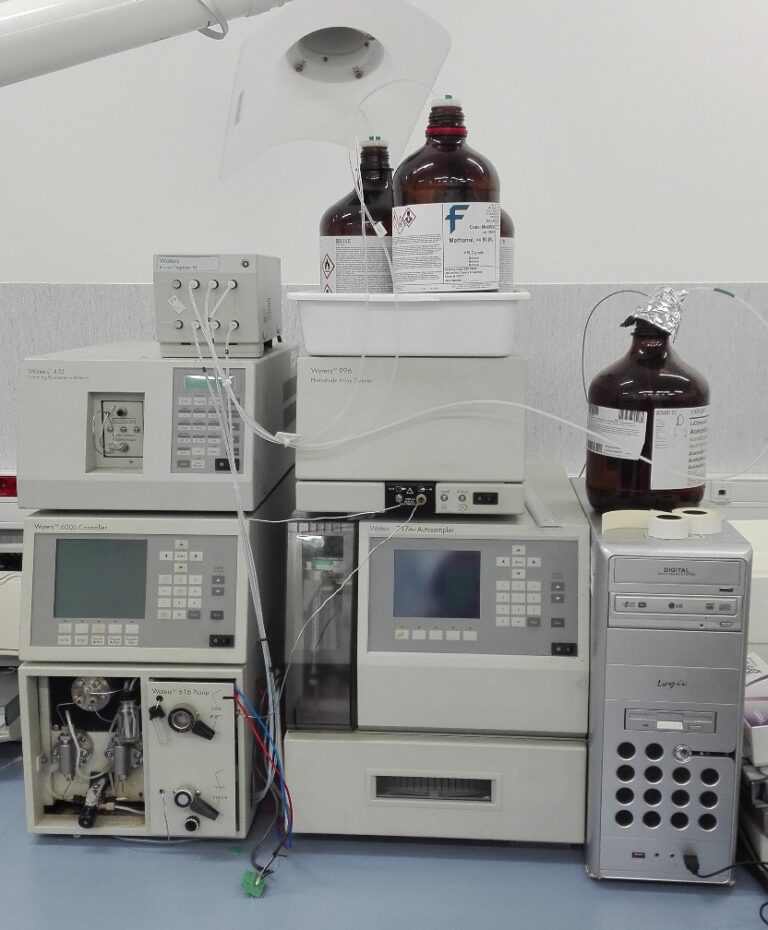
- HPLC – PDA – FLD by Dionex coupled with a detector photodiode in the range 180 – 560 nm and a fluorescence detector (FDA) with a flow range of 0.5 to 8.0 ml/min,

- Semi-preparative HPLC – ELSD by Gilson coupled with an evaporative light scattering detector (ELSD) with a flow range from 1 to 12 ml/min.
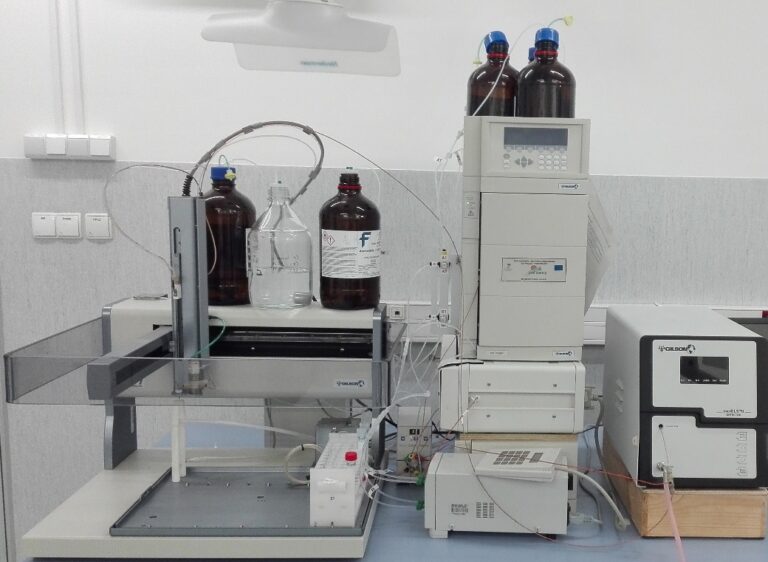
Typical applications for these instruments are:
- isolation of secondary metabolites (high purity) for structure determination by NMR and biological activity testing,
- isolation of reference substances for the standardization of biological materials, food and feed.
Contact:
Dr Jarosław Mołdoch
e-mail: jmoldoch@iung.pulawy.pl
phone: +48 81 47 86 885
Sample preparation laboratory
The Department equipment enables to samples preparation with all caution at each step of the process for the sake of chemically unstable substances.

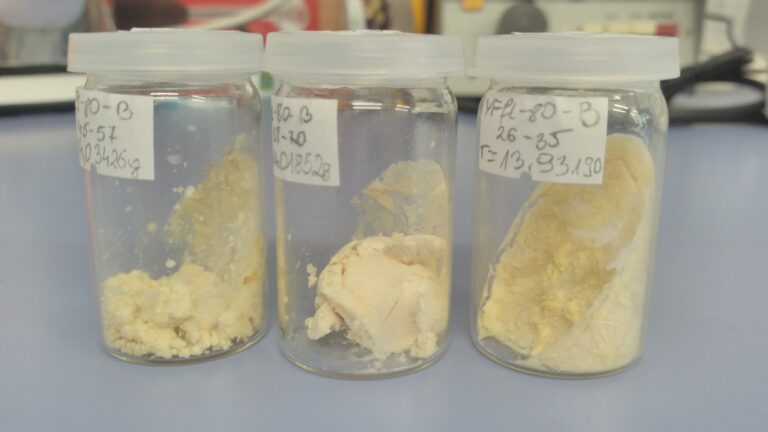

CHRIST’s Gamma 2-16 LSC freeze dryer
Freeze dryer enabling freeze drying of samples in a wide range of temperatures (-55°C) – (+50 °C) and pressures (<0.01 mbar).
The device allows sublimation removal of water (and some organic solvents, e.g. t-BuOH, DMSO) at reduced temperature and under reduced pressure, from frozen solutions and biological materials, e.g. extracts, suspensions, whole plants and fruit / vegetables. Due to the use of reduced temperature, it is possible to dry thermolabile samples.
Freeze drying is carried out on 5 shelves with a diameter of 20 cm and 3 shelves with a diameter of 37 cm.
Accelerated Solvent Extraction System Dionex ASE 200
Accelerated Solvent Extraction System Dionex ASE 200 allows to significantly reduce the extraction time and solvent consumption by up to 90%. The autosampler with a 24-site rotor and extraction cells volumes available in 1 – 33 mL enable a series of analyses with a wide range of samples weight. The system can work with aqueous and organic solvents. Temperature and pressure control accelerates the kinetics of the extraction process. The solvent boiling prevention makes extraction safer, faster and more efficient than traditional techniques.
The Department is equipped with various sizes of vacuum evaporators with coolant liquid recirculation.
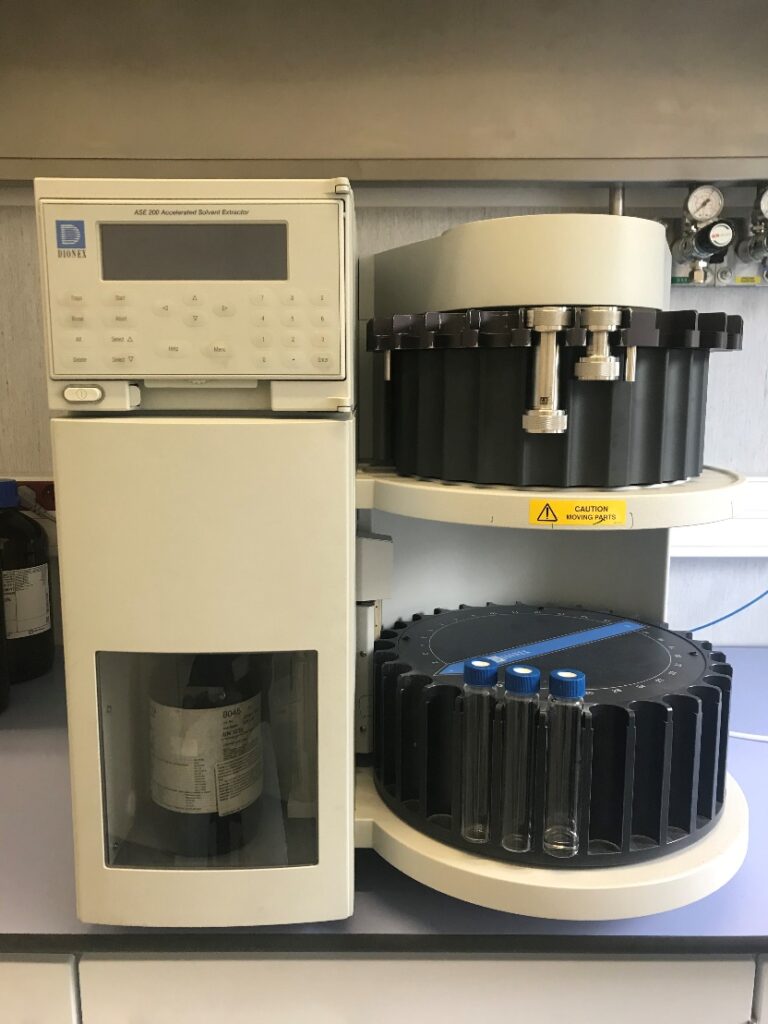
Heidolph semi-technical rotary evaporator (up to 20 liters)
Rotary evaporator which enables the evaporation of solvents with a wide range of boiling points thanks to the chemically resistant KNF SBC LABOBASE 860 vacuum pump (60 L/min, 2 mbar. final pressure) and an efficient cooler powered by a Huber Unichiller UC025 circulator (2.5 kW at 15 °C). The device allows for quick evaporation of both organic solvents and water from plant extracts and other materials while maintaining low temperature of the solution, which is very important when processing temperature-sensitive substances. Additionally, it is possible to evaporate solutions that tend to spatter and foam, thanks to the additional expansion vessel.
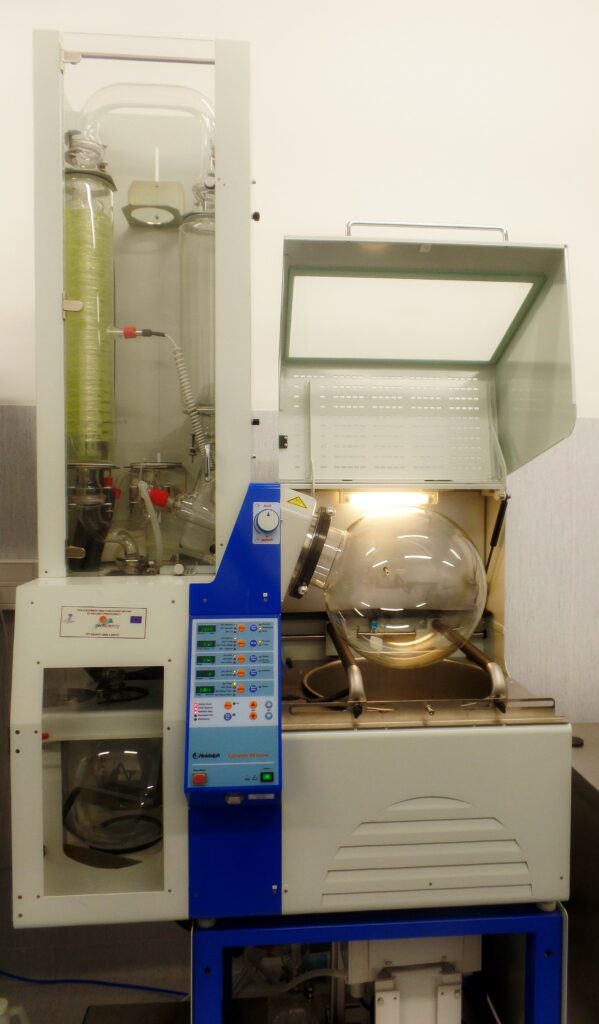
Multivapor P – 12 Buchi
Multivapor rising laboratory efficiency and throughput. It can work with many types of solvents through the use of many different operating parameters, such as the bath temperature or the shaking speed. The system of separate baths ensures safety in terms of cross-contamination of samples. The system is equipped with a V-710 Buchi vacuum pump with a capacity of 3.1 m3/h, guaranteeing an ultimate vacuum of ≤ 1.5 mbar and a 500W F-105 Buchi recirculation pump.
